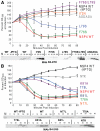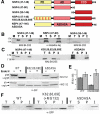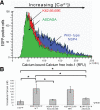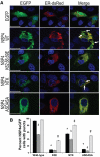Rotavirus disrupts calcium homeostasis by NSP4 viroporin activity
- PMID: 21151776
- PMCID: PMC2999940
- DOI: 10.1128/mBio.00265-10
Rotavirus disrupts calcium homeostasis by NSP4 viroporin activity
Abstract
Many viruses alter intracellular calcium homeostasis. The rotavirus nonstructural protein 4 (NSP4), an endoplasmic reticulum (ER) transmembrane glycoprotein, increases intracellular levels of cytoplasmic Ca(2+) ([Ca(2+)]cyto) through a phospholipase C-independent pathway, which is required for virus replication and morphogenesis. However, the NSP4 domain and mechanism that increases [Ca(2+)]cyto are unknown. We identified an NSP4 domain (amino acids [aa] 47 to 90) that inserts into membranes and has structural characteristics of viroporins, a class of small hydrophobic viral proteins that disrupt membrane integrity and ion homeostasis to facilitate virus entry, assembly, or release. Mutational analysis showed that NSP4 viroporin activity was mediated by an amphipathic α-helical domain downstream of a conserved lysine cluster. The lysine cluster directed integral membrane insertion of the viroporin domain and was critical for viroporin activity. In epithelial cells, expression of wild-type NSP4 increased the levels of free cytoplasmic Ca(2+) by 3.7-fold, but NSP4 viroporin mutants maintained low levels of [Ca(2+)]cyto, were retained in the ER, and failed to form cytoplasmic vesicular structures, called puncta, which surround viral replication and assembly sites in rotavirus-infected cells. When [Ca(2+)]cyto was increased pharmacologically with thapsigargin, viroporin mutants formed puncta, showing that elevation of calcium levels and puncta formation are distinct functions of NSP4 and indicating that NSP4 directly or indirectly responds to elevated cytoplasmic calcium levels. NSP4 viroporin activity establishes the mechanism for NSP4-mediated elevation of [Ca(2+)]cyto, a critical event that regulates rotavirus replication and virion assembly.
Figures








Similar articles
-
Activation of the endoplasmic reticulum calcium sensor STIM1 and store-operated calcium entry by rotavirus requires NSP4 viroporin activity.J Virol. 2013 Dec;87(24):13579-88. doi: 10.1128/JVI.02629-13. Epub 2013 Oct 9. J Virol. 2013. PMID: 24109210 Free PMC article.
-
The Rotavirus NSP4 Viroporin Domain is a Calcium-conducting Ion Channel.Sci Rep. 2017 Mar 3;7:43487. doi: 10.1038/srep43487. Sci Rep. 2017. PMID: 28256607 Free PMC article.
-
Genetic divergence of rotavirus nonstructural protein 4 results in distinct serogroup-specific viroporin activity and intracellular punctate structure morphologies.J Virol. 2012 May;86(9):4921-34. doi: 10.1128/JVI.06759-11. Epub 2012 Feb 22. J Virol. 2012. PMID: 22357281 Free PMC article.
-
Rotavirus protein expression is important for virus assembly and pathogenesis.Arch Virol Suppl. 1996;12:69-77. doi: 10.1007/978-3-7091-6553-9_8. Arch Virol Suppl. 1996. PMID: 9015103 Review.
-
A hypothesis about the mechanism of assembly of double-shelled rotavirus particles.Arch Virol Suppl. 1996;12:79-85. doi: 10.1007/978-3-7091-6553-9_9. Arch Virol Suppl. 1996. PMID: 9015104 Review.
Cited by
-
Structural and Functional Aspects of Ebola Virus Proteins.Pathogens. 2021 Oct 15;10(10):1330. doi: 10.3390/pathogens10101330. Pathogens. 2021. PMID: 34684279 Free PMC article. Review.
-
Interaction of Teleost Fish TRPV4 with DEAD Box RNA Helicase 1 Regulates Iridovirus Replication.J Virol. 2023 Jun 29;97(6):e0049523. doi: 10.1128/jvi.00495-23. Epub 2023 Jun 8. J Virol. 2023. PMID: 37289063 Free PMC article.
-
Viperin, an IFN-Stimulated Protein, Delays Rotavirus Release by Inhibiting Non-Structural Protein 4 (NSP4)-Induced Intrinsic Apoptosis.Viruses. 2021 Jul 8;13(7):1324. doi: 10.3390/v13071324. Viruses. 2021. PMID: 34372530 Free PMC article.
-
Network Pharmacology-Based Strategy for Predicting Active Ingredients and Potential Targets of Gegen Qinlian Decoction for Rotavirus Enteritis.Evid Based Complement Alternat Med. 2020 Jul 29;2020:2957567. doi: 10.1155/2020/2957567. eCollection 2020. Evid Based Complement Alternat Med. 2020. PMID: 32802121 Free PMC article.
-
Mechanisms of Nausea and Vomiting: Current Knowledge and Recent Advances in Intracellular Emetic Signaling Systems.Int J Mol Sci. 2021 May 28;22(11):5797. doi: 10.3390/ijms22115797. Int J Mol Sci. 2021. PMID: 34071460 Free PMC article. Review.
References
-
- Dubyak G. R. 2004. Ion homeostasis, channels, and transporters: an update on cellular mechanisms. Adv. Physiol. Educ. 28:143–154 - PubMed
Publication types
MeSH terms
Substances
Grants and funding
LinkOut - more resources
Full Text Sources
Miscellaneous

